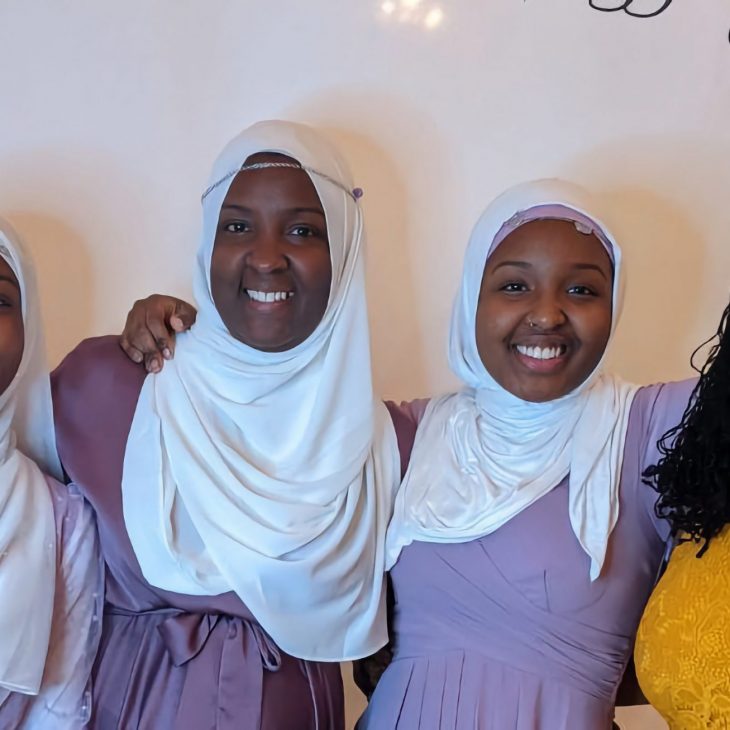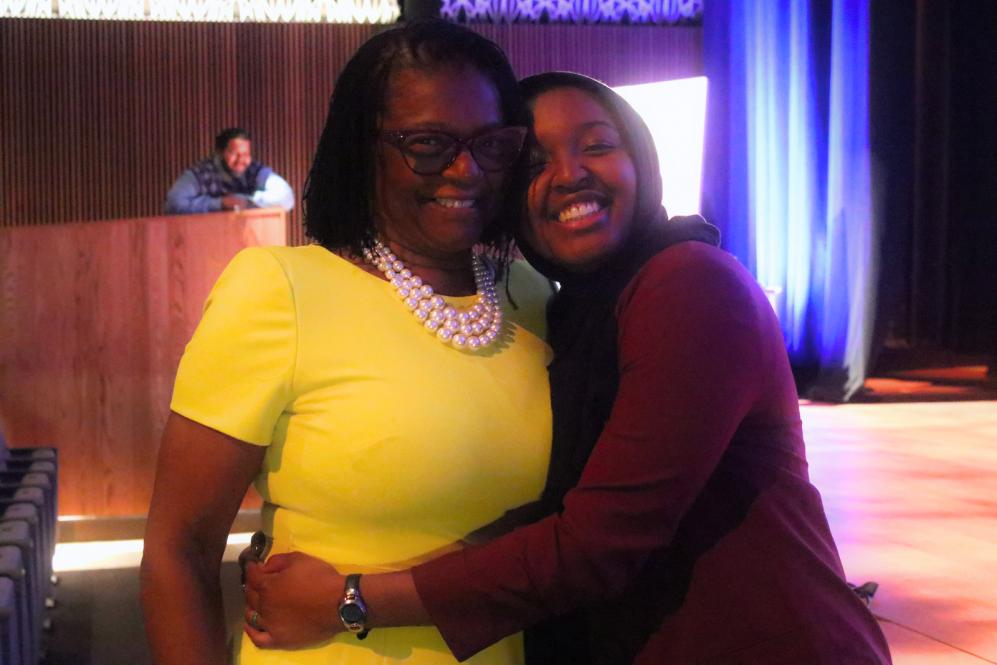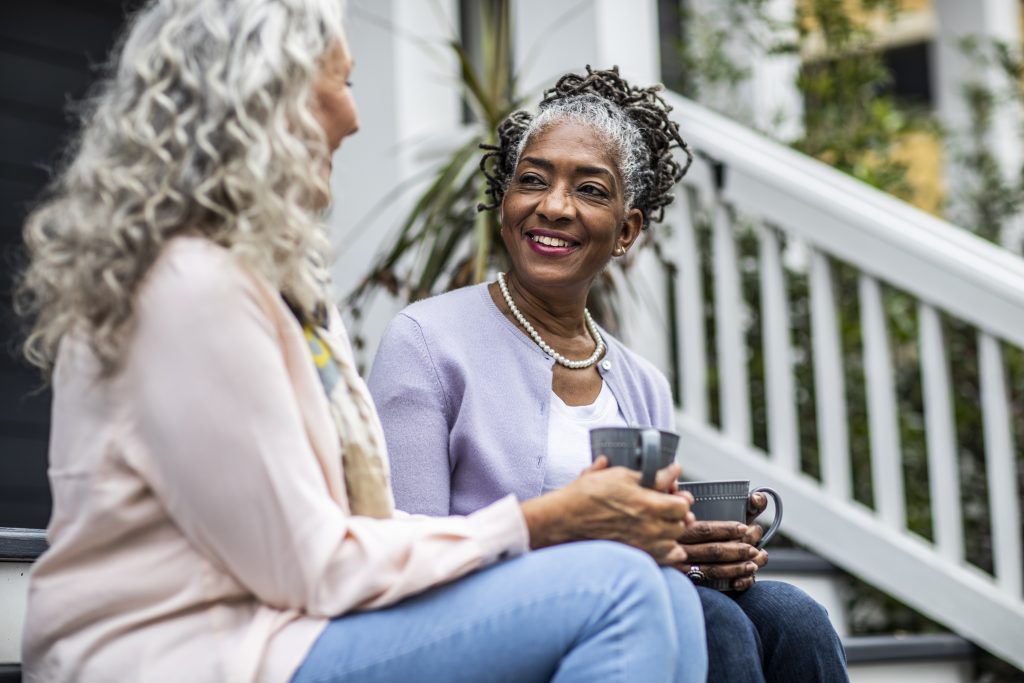Black and Interfaith: A Family Finds God Through Love and Intersectionality
January 17, 2023

On a hot summer day in Wheaton, Maryland, during Ramadan in 2010, 7-year-old Sasa Aakil and her siblings sat around their grandmother as she sliced a watermelon.
Iftar was still a few hours away and the cold fresh fruit would be a part of the feast after a long arduous day of fasting. So, they were surprised when instead of putting the fruit away in the fridge, their grandmother offered the plate to the exterminator who had been working in their home that morning. He gladly accepted the offering, much to the dismay of the hungry children.
“We were all little, it was my first or second time fasting during Ramadan, which is especially hard in the summer. So, we were all jealous watching this man eat the watermelon in front of us,” said Aakil. But what stayed with her the most is how in that moment her grandmother, who’s Christian, could’ve eaten the fruit too but chose to fast with them instead in solidarity.
Aakil, 19, is a writer, potter, visual artist, and the 2021 Montgomery County (Maryland) Youth Poet Laureate. Much of her work is inspired by her faith and is like love letters to her family and community.
Aakil’s childhood memories are filled with stories of love and solidarity in her interfaith home. Stories of reciting Islamic prayers and saying grace together before eating family dinners and saying amen in unison, of going to churches and Friday Jummah prayers, of Christmas parties and Eid feasts filled with halal dishes and a glass of alcohol. For many interfaith families across the country, like Aakil’s, the intersectionality of their identities influencing their religious understanding is a common experience.
In conversation with Silma Suba of Interfaith America Magazine, Aakil joins her grandmother, Alice Barnett, and mother, Latifa Barnett, to talk about growing up in an interfaith family, how faith and racial justice are connected, and how her faith inspires her to create art.
Silma Suba: When did your family’s interfaith journey begin?
Alice Barnett: At some point in my life journey, I discovered that God was everybody’s God. God loves us all, and we all belong to God. I am a Christian, and that is my faith. My ex-husband was Anglican when we married, and when we were in college, he began his journey of self-knowledge and became Muslim. We had two children, and I could either choose to tell them to stay away from their father because he’s Muslim, or I could embrace his faith and allow my daughters to drink from both fountains, so to speak.
As they were growing in their faith, I made sure that I was a part of that journey. I would attend Jummah services and scholarly lectures with them, so that I knew as much about his faith as he was exposing them to, and so that I could feel comfortable with them doing that. In that journey, I was able to reconcile myself to the fact that there was me, and then there was him, and that we were able to amazingly balance it all. My children loved going to church and as they grew both of them decided that Islam made more sense to them in terms of their faith, and that’s where they landed. And it didn’t matter to me, because they were still God-loving and God-fearing, and that’s how we have continued.
When I moved to Maryland in 2003, I just became a part of the Muslim community, and it was an easy transition for me. There was no conflict because we all love and feel God, and that to me is the only thing that I need to know about anyone. I used to go to the Jumah prayers on Fridays at this Masjid in D.C., and in my mind, it was just like preaching and I kept saying, “Yeah! Amen!” all through the service. When it ended, my daughter was like mom we Muslims don’t do that, that’s what we do in the church. But no one said anything to me or looked at me, and I was just enjoying the service in my own way.
Share
Related Articles
Interfaith Inspiration
American Civic Life
Higher Education
What Does Interfaith Engagement Mean from an Evangelical Perspective?
Watch Sasa Aakil perform the poem
“I grew up in a home of Allahuakbars and Amens.”
SS: What was it like growing up in an interfaith family?
Latifa Barnett: There was never any talking down of the other person’s faith. I never felt any guilt about fasting and celebrating Ramadan or felt like I was betraying my mother by doing that. And when I celebrated Christmas and Easter, they never put me in a position where I felt like I had to not enjoy the tradition or the celebration because I would be betraying the other parents. Sometimes parents do that to their children, but mine didn’t. They just allowed me to be a child and enjoy what I enjoyed, regardless of whatever their specific personal preference was. That was so valuable to me because it allowed me to see the beauty in both religions. Even to this day.
Yes, there are different beliefs, but I think that the overriding belief in God and the belief in one’s life in order to move nearer to Him, that is what brings people’s hearts and souls together. And I think often in the Black community when it comes to interfaith, that’s how it is. There was a book I read a few years ago by an African American woman where the child was Muslim and the grandmother was Christian, and it reminded me so much of my family. In the book the little girl is wearing her hijab for the first time and her grandmother says, “You look so beautiful,” and I was like, that’s the kind of experiences we had where everyone loved each other because we are family, and our different religions didn’t come between us.
Sasa Aakil: My entire life I have benefited from the hard work of other people. I think my mom, my grandma, even my grandpa, and our extended family, the effort they put in to create this loving space [at home] is something that I’ve benefited from so much. Having an interfaith family was so natural to me. To this day, when people see a picture of my grandma, and they’re like, “Why isn’t she hijabi?” for a second, I get confused, because I’m like, what is the question? Because I forget that it’s a thing to other people externally, for me and my entire family to be Muslim, covering, visibly Muslim, and then for my grandma and my other family not to be.
Grandma fasted with us during Ramadan, and she bought us Eid gifts, and we went to Thanksgiving, and she cooked us halal lamb roast so we can eat. Oftentimes, when I walk out into the world, because of the reactions of others, I’m forced to think about this visible Muslim exterior that I have [my hijab], but at a family gathering like Thanksgiving with my extended non-Muslim family, I never had to think about that.
So, for me, it’s always been beautiful. But, of course, there is that layer of growing up in post-9/11 America. I have been forced to acknowledge the strangeness of my existence because of the opinions of other people, because of other people’s thoughts. My mom did a very good job of instilling into me and my siblings a love of God. What can be more beautiful than the commonality of our belief in God? That’s the big thing about my interfaith family definitely – I love you, you love me, we love God. What more is needed?

Alice Barnett (left) with Sasa Aakil, at Interfaith America’s “Celebrating Black Interfaith” event in Washington D.C.., November 3, 2022. Photo courtesy of Silma Suba
SS: What’s something you have learned about faith from your family?
Sasa: An important thing about being Black and Muslim is that we all have a very strong conviction for justice, because to be Black in America is to fight for our justice and our rights every single day. That’s one thing that I really got from both my mom and my grandma, that faith is about truth, and truth is in God, and God is most just. So, standing up for justice is very much something that I felt like I had to do, not necessarily had to do as if I didn’t, I would be failing, but had to do as in the very core of my being insisted upon it. Because that’s what it means to be who I am.
SS: When did you begin writing poetry?
Sasa: I started writing when I was nine. I was homeschooled, and my mom decided she was going to teach me about poetry. She literally gets credit for every cool thing about me. She noticed how much I liked it, so we did another poetry unit, and I really, really loved it. That’s how I started writing for fun. I did that because I grew up very frustrated with the world. Because I was very much conscious of all the injustices, and I couldn’t understand why they existed. I had to do something about it, so I put it into poetry. And I didn’t share my poetry for years, and for like a long time, I was just writing horrible, horrible poems, and not sharing them with anyone. But the first time I performed I was 13. I did a poem accompanied by my brother who was singing in front of a small event at my community. The poem was about the Prophet’s daughter and talked about her life or impact.
SS: How does faith show up in your work?
Sasa: My faith showed up in my work sometimes very explicitly because I was writing for our local community mosque events. I was writing specifically about the Prophet, or his daughter, and that sort of thing. The other way my faith shows up more subtly in my work is through my deep value for justice to my faith and my community.
I started taking poetry classes at Words Beats & Life Inc. (a cultural center in Washington D.C.), where I got involved with doing poetry slams and writing books. I learned in this place that poetry can be used as advocacy, that poetry was powerful. That art can be used as a tool for justice. These were things that I kind of knew but wasn’t really given an opportunity to explore. I learned both the importance of art to advocate but also the importance of art to just be art. I had a lot of room to occupy both of those spaces, which a lot of young poets of color don’t get. We’re only told that our art needs to have a purpose, but it doesn’t.
I very distinctly remember when Trayvon Martin was killed. I think I was 12, and that was the first time I realized that this world truly did not love my people. This country truly did not love my people. And that was really painful, and it was a shock. So, what I did for myself in that moment was turn to the page and figure out ways to make it known that that was not okay. It was also to find some way for that knowledge to rest more easily inside of me. That’s where all the racial justice started showing up [into my work.] You can’t be Black and not be aware of these kinds of things, so it was a natural progression of my writing.
SS: How does it feel to have a youth poet laureate in the family?
Alice: I thank God often for Latifa and her children. God is in all of that – when I hear her poem, I say, “God, I witness all of that and I know that it comes from you.” She has wisdom, she has insight beyond her age, beyond anything we could have taught her as parents and grandparents, and she continues to amaze me. I get chills when I read her work and hearing her is even more impactful.
Latifa: I’m going to give my mother credit too. Because my mother and her mother before her and our people were always about living the faith, you can’t just say that you believe in God, and then act a fool. You have to bring that belief in God to everything that you do. I tried really hard to pass that on to my children. You say you believe in God – what does that mean? Oh, you say you’re a poet. So how does that reflect your belief in God? But you say you’re an artist. So, what are you doing to spread God’s word? So, when I see her writing and reciting and representing, I feel like she took that lesson, that’s been a lesson that’s been passed down to us. I don’t know what my ancestors who were enslaved have had to go through on a daily basis, but I do know that this is the answer to some of their prayers.
SS: What’s a message you want people to walk away with from your work?
Sasa: I want them to know that the full credit for my existence goes to my mom and my grandma and all the women who raised me, they are my blessing. It is important for us in life as religious people to strive toward God. And for me, what that looks like, is striving toward justice. And so, I think, as people, we all need to come together and advocate for justice in our world and to create a better world. And art is a great way to do that, but it’s not the only way.



